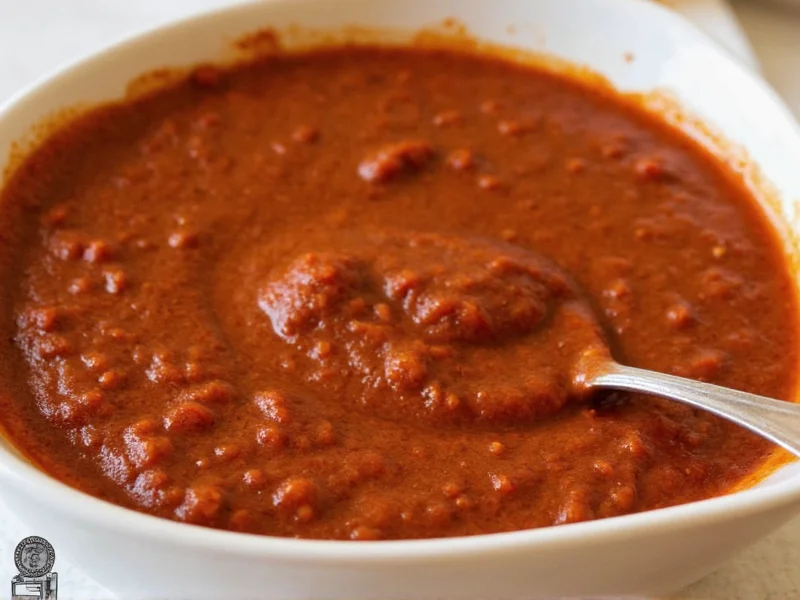Mole sauce represents one of Mexico's most sophisticated culinary achievements, with origins tracing back to colonial-era convents. This complex sauce combines up to 30 ingredients including dried chilies, chocolate, spices, nuts, and sometimes fruit, creating a flavor profile that balances sweet, savory, spicy, and earthy notes. Understanding how to use mole sauce properly unlocks its potential across countless dishes.
Traditional Mole Applications
While many associate mole exclusively with chicken, its traditional uses span multiple proteins and preparations. Authentic Mexican cuisine typically serves mole over poultry, particularly turkey or chicken, accompanied by white rice and warm tortillas. The sauce's complexity complements the mild flavor of these proteins while the traditional preparation method involves simmering the meat directly in the sauce for optimal flavor absorption.
Creative Culinary Adaptations
Modern cooks have expanded mole sauce uses far beyond traditional preparations. Creative applications include:
- As a base for enchiladas or tamales
- Drizzled over roasted vegetables like sweet potatoes or cauliflower
- Enhancing soups and stews with depth of flavor
- Marinating tofu or tempeh for vegetarian dishes
- As a dipping sauce for empanadas or quesadillas
- Blended into salad dressings for unique flavor profiles
| Protein Type | Recommended Mole Variety | Cooking Method | Preparation Time |
|---|---|---|---|
| Chicken | Mole Poblano | Braised in sauce | 2-3 hours |
| Beef | Mole Negro | Slow-cooked with sauce | 3-4 hours |
| Seafood | Mole Coloradito | Lightly coated before serving | 30 minutes |
| Tofu | Mole Amarillo | Marinated then pan-fried | 1 hour (including marinating) |
Breakfast and Brunch Innovations
One of the most surprising mole sauce uses involves breakfast applications. Try incorporating mole into your morning routine by:
- Drizzling over scrambled eggs or omelets
- Using as a base for huevos rancheros
- Mixing with breakfast potatoes before roasting
- Creating mole-infused breakfast burritos
- Adding a spoonful to morning smoothies for depth (use sparingly)
These creative mole sauce recipes for breakfast transform ordinary morning meals into extraordinary culinary experiences while introducing complex flavors early in the day.
Vegetarian and Vegan Applications
Mole sauce naturally lends itself to plant-based cooking when prepared without animal products. Many traditional mole recipes are inherently vegetarian, making them perfect for:
- Coating roasted vegetable stacks
- Enhancing bean and grain bowls
- Creating flavorful vegetarian tamales
- Drizzling over stuffed peppers or squash
- As a sauce for vegetable enchiladas
When using mole sauce with vegetables, consider roasting or grilling the produce first to create caramelized surfaces that better absorb the sauce's complex flavors. This technique significantly enhances what to serve with mole sauce in vegetarian preparations.
Storage and Preservation Techniques
Proper storage extends mole sauce uses across multiple meals. Follow these guidelines:
- Refrigerate in airtight containers for up to 2 weeks
- Freeze in portion-sized containers for up to 6 months
- Store in ice cube trays for single-serving portions
- Always cool completely before storing
- Reheat gently over low heat, adding broth if too thick
These mole sauce storage tips ensure you always have this versatile ingredient ready for impromptu meals. Freezing in small portions allows for easy incorporation into soups, stews, or as a flavor boost for weeknight dinners.
Common Mistakes to Avoid
When working with mole sauce, many home cooks make these errors:
- Boiling the sauce vigorously (causes separation)
- Adding too much at once (overwhelms other flavors)
- Not adjusting seasoning after heating (requires balancing)
- Using low-quality store-bought versions without enhancement
- Pairing with incompatible flavors (avoid strong competing spices)
Understanding these pitfalls helps maximize mole sauce's potential in everyday cooking. Remember that mole works best when it complements rather than dominates a dish, allowing its complex flavor profile to shine through subtle integration.
Conclusion
Mole sauce's versatility extends far beyond its traditional applications, offering endless possibilities for creative cooking. From breakfast to dinner, vegetarian to meat-based dishes, this complex sauce enhances flavors while adding cultural depth to everyday meals. By understanding proper storage techniques and creative applications, home cooks can transform simple ingredients into extraordinary culinary experiences using this Mexican treasure.
Frequently Asked Questions
Can mole sauce be used as a marinade?
Yes, mole sauce makes an excellent marinade for chicken, turkey, pork, or tofu. Allow proteins to marinate for 2-4 hours (or overnight for tougher cuts) before cooking. The complex flavors in mole penetrate the meat while the natural sugars help create a beautiful caramelized exterior when grilled or roasted.
What vegetables pair best with mole sauce?
Roasted sweet potatoes, cauliflower, zucchini, and bell peppers work exceptionally well with mole sauce. The natural sweetness of these vegetables complements mole's complex flavor profile. For best results, roast vegetables until caramelized before adding the sauce, allowing the textures and flavors to integrate properly.
How can I adjust the consistency of mole sauce for different uses?
For dipping applications, keep mole sauce slightly thicker. For coating proteins or vegetables, thin with chicken or vegetable broth until it reaches a pourable consistency. When using as a base for soups or stews, you can incorporate it directly without thinning. Always adjust consistency after heating, as mole thickens when cooled.
Can mole sauce be used in desserts?
While unconventional, certain mole varieties (particularly those with higher chocolate content) can enhance desserts. Try drizzling thinned mole over vanilla ice cream, incorporating small amounts into chocolate cakes, or using as a filling for churros. When using mole in desserts, balance its complexity with sweet elements and use sparingly until you determine the right proportion for your taste.
How do I enhance store-bought mole sauce?
To elevate store-bought mole, simmer it with additional ingredients like toasted sesame seeds, a splash of orange juice, or a pinch of cinnamon. For richer flavor, incorporate a small amount of high-quality chocolate or toasted almonds. Always taste and adjust seasoning after heating, as commercial versions often require balancing with salt, acid, or sweetness to reach optimal flavor.











 浙公网安备
33010002000092号
浙公网安备
33010002000092号 浙B2-20120091-4
浙B2-20120091-4